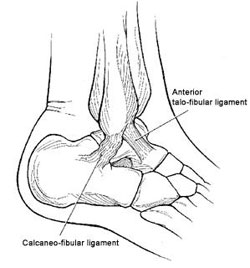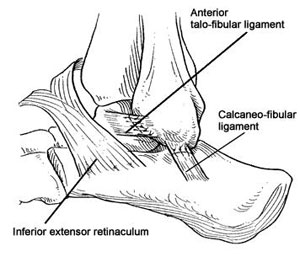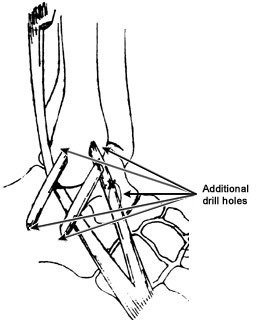Ankle Instability: Causes, Diagnosis and Treatment
Overview
Every day an estimated one out of every 10,000 people sprain their ankle, an injury in which one of the two major ligaments on the outer portion of the ankle is stretched and/or torn. (As shown below, these are the anterior talofibular ligament and the calcaneofibular ligament.)
In the great majority of cases, individuals who see a physician for their injury are instructed on how to reduce pain and inflammation. They may be advised to wear an air cast or participate in physical therapy to strengthen the ankle muscles, in order to make a full recovery.

Line drawing of the anatomy of the lateral or outer ankle with the two major ligaments.
The remaining population—about 10% of people—develop ankle instability, a condition in which, although the ligament has healed, it has done so in a lengthened position. As a result, the person is prone to a feeling of the ankle "giving out" and to additional sprains. Athletes such as ballet dancers, who already have looser-than-average ligaments, are particularly likely to develop this condition.
Diagnosis
The orthopaedic surgeon diagnoses ankle instability through a physical assessment for mechanical instability (motion beyond the normal physiological range) and through the use of taler tilt (or stress) x-rays. In a healthy ankle, this tilt should only extend to about 5°; in the patient with an unstable ankle, the tilt will extend to 15-20° on x-ray.
Treatment
Treatment for ankle instability begins with a regimen of exercises intended to strengthen the muscles of the outer ankle, in an attempt to compensate for the loss of stability formerly provided by the ligament. While this treatment is helpful for many patients, it may be less successful in individuals whose muscles are already quite strong, such as dancers or other athletes. If instability is primarily a problem when participating in specific recreational activities, it may be addressed by taping the ankle and/or with the use of a brace, either one that is worn in an athletic shoe, or one that laces around the ankle. However, if these measures are not adequate to restore stability and the patient continues to experience a feeling of instability during everyday activities, surgical repair of the injury may be advised.
According to Martin J. O’Malley, MD, Associate Attending Orthopaedic Surgeon at the Hospital for Special Surgery (HSS), surgical intervention falls into two main categories:
1) The preferred is an anatomic reconstruction, in which the stretched or torn ligaments is repaired and allowed to heal in a shorten position. This reconstruction can be accomplished by using the patient’s own tissue, also known as a Broström procedure, or utilize a cadaver tendon, also called an allograft, if the patient’s own tissue is too stretched out or different. For added stability and to help prevent re-injury, the surgeon may also tighten the retinaculum, a band of fibrous tissue that helps hold the ankle in proper alignment.
2) The second type of surgery is peroneal substitution ligament reconstruction, a procedure in which the ligament is replaced entirely with another piece of tendon from the patient’s ankle. This procedure is less ideal as the main dynamic stabilizer of the ankle, the peroneal tendon, is used.

Anatomic reconstruction.
In almost all cases, anatomic reconstruction is possible and preferable. This procedure offers the advantages of maintaining full mobility of the joint, a smaller incision, and a more rapid recovery. The primary drawback of this procedure is that ligaments may become loose a second time and require additional repairs, but this is rare. Results of the Broström procedure performed at HSS are excellent. In a case series of seventy-three patients, all but one was satisfied with the procedure and would have the procedure again.
However, anatomic reconstruction, using a patient’s own tissue, is not possible in every case, for example, when the tissue have been too damaged and are insufficient for repair. When the torn ligament is too badly damaged we utilize a tendon allograft. Peroneal substitution ligament reconstruction requires a larger incision than anatomic reconstruction, has a somewhat longer recovery period, and carries a risk of nerve irritation, which can lead to chronic pain. We rarely use a non-anatomic personal substitution ligament reconstruction because it sacrifices a good tendon, has higher instances of post-operative stiffness and pain.

Peroneal Substitution
All types of surgery may be done using an epidural - the same type of anesthesia that many women receive during childbirth - so that the patient may be awake during their surgery if they so choose. An overnight stay in the hospital is not necessary.
Long-term outcome for both of these surgical procedures is generally quite good, provided that there is no arthritis present in the ankle. Ankle instability is not necessarily associated with ankle arthritis. However, if the bones of the ankle have been rubbing against each other over the course of many years owing to chronic ankle instability, then the latter condition may contribute to the wearing away of cartilage, and the development of arthritis in the joint.
Following surgery, the ankle is placed in a plaster splint and the patient must use crutches or a knee scooter to avoid placing any weight on the affected foot. At two weeks, the plaster splint is replaced with a cast or removable boot, which is worn for an additional 2 to 4 weeks. Formal physical therapy is started at 6 weeks and an ankle support is worn for walking until 12 weeks after surgery. "By ten to twelve weeks, most people no longer require a brace and can return to all their normal activities including participation in sports," says Dr. O’Malley.
At HSS, orthopaedic surgeons also treat patients who require a second surgery after anatomic reconstruction, because the ligaments have once again become too loose. In these cases, replacement with a tendon may be advised. Individuals who have undergone ankle ligament reconstruction may also seek treatment if they are experiencing pain due to nerve irritation or ankle stiffness. These situations can be very difficult and should be treated by an experienced foot and ankle surgeon.
Summary Prepared by Nancy Novick
Authors
Attending Orthopedic Surgeon, Hospital for Special Surgery
Professor of Clinical Orthopedic Surgery, Weill Cornell Medical College

